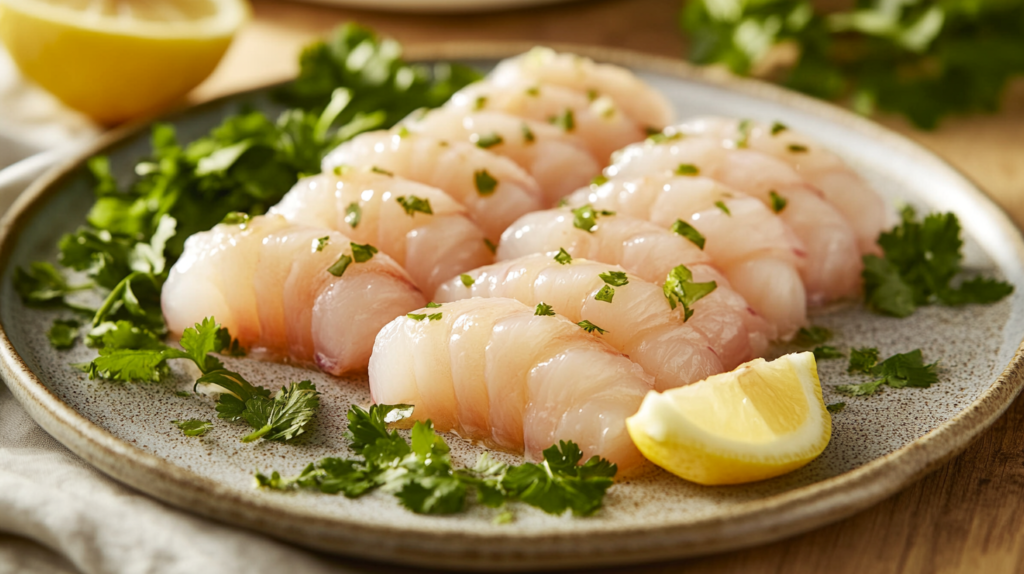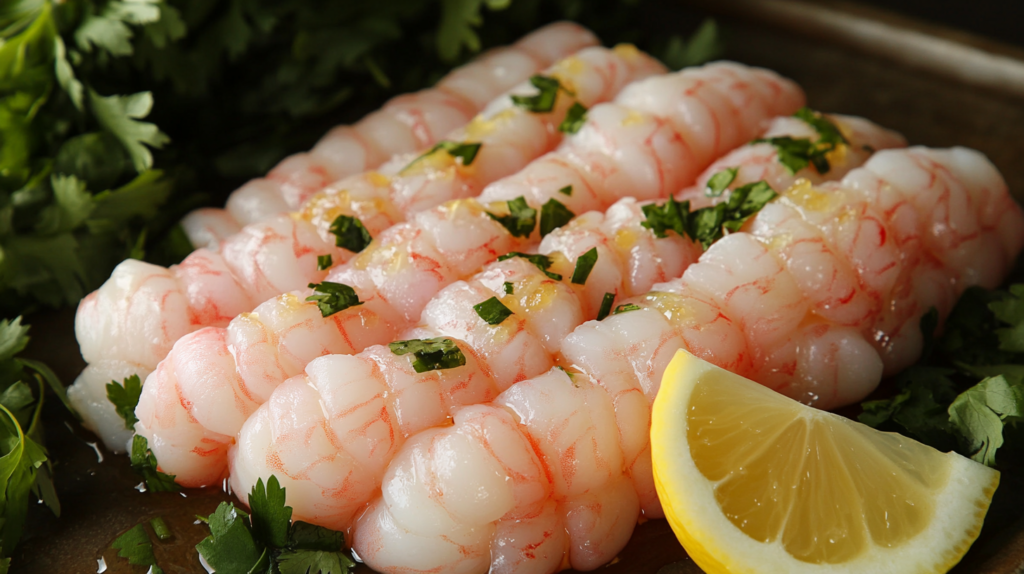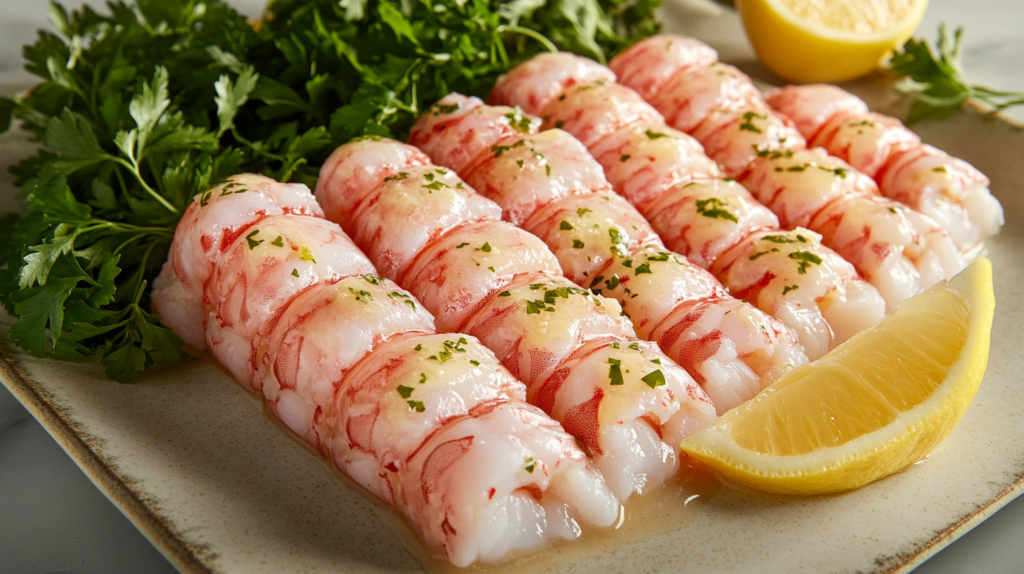Introduction to Langostino
Langostino, often referred to as a delicacy of the sea, is prized for its tender meat and mild, sweet flavor. Its versatility and affordability have made it a favorite ingredient in dishes ranging from seafood pasta to tacos. Whether you’re a seafood connoisseur or a curious foodie, understanding what makes langostiino unique adds a layer of appreciation to its culinary appeal.
What is Langostino?
langostiino is a type of shellfish that belongs to the squat lobster family, despite not being a true lobster. Its name, which translates to “little lobster” in Spanish, reflects its resemblance to lobsters. langostiino meat is found in the tail and is known for its soft texture and sweet, delicate flavor. Often sold pre-cooked and frozen, it’s a convenient choice for quick and delicious seafood dishes.
The Differences Between langostiino, Lobster, and Shrimp
- Physical Appearance:
- Langostino is smaller than a lobster but slightly larger than shrimp. It has a stubby tail and a body shape closer to a lobster.
- Flavor Profile:
- Langostino’s flavor is sweeter and less briny than shrimp, with a softer texture compared to lobster.
- Culinary Uses:
- While lobster is typically served whole or in chunks, langostino is often used in pasta, salads, and soups. Shrimp is versatile but has a firmer texture.
- Cost and Availability:
- Langostino is more affordable than lobster, making it a popular substitute in dishes where lobster is traditionally used.
The Global Appeal of Langostino
- Culinary Versatility:
- Langostino’s mild flavor allows it to adapt to various cuisines, from Italian seafood pastas to Latin American ceviches.
- Accessibility:
- Available frozen and pre-cooked, langostino is easy to prepare, making it a favorite for home cooks and chefs alike.
- Sustainability:
- In many regions, langostino is considered a more sustainable seafood option compared to traditional lobster or shrimp.
- Popular Dishes:
- Langostino is featured in globally inspired dishes like langostino tacos, creamy bisques, and buttery rolls, appealing to a wide range of palates.
Langostino’s unique qualities and versatility make it a standout ingredient in the world of seafood. Whether you enjoy it as a substitute for lobster or as the star of its own dish, its delicate sweetness and tender texture are sure to impress.
The Biology of Langostino
langostiino, with its unique characteristics and fascinating life cycle, plays a vital role in the marine ecosystem. Understanding its biology helps to appreciate this small but mighty shellfish beyond its culinary appeal.
Habitat and Distribution
- Where langostiino Lives:
- Langostino is typically found in cold and temperate waters, thriving in regions like the eastern Pacific Ocean, particularly off the coasts of Chile and Peru. Some species also inhabit the North Atlantic.
- Preferred Environment:
- They live in rocky seabeds and sandy substrates, often at depths ranging from 50 to 500 meters, where they find shelter and food.
- Geographical Range:
- Langostino species are common in South America, Europe, and parts of Asia, making them a globally recognized seafood source.
Physical Characteristics
- Size and Appearance:
- Langostino is small, measuring 5–8 inches in length. It has a hard shell, a stubby tail, and pincers, resembling a miniature lobster.
- Coloration:
- Their shells are usually a reddish or pinkish hue, which becomes more vibrant when cooked.
- Distinct Features:
- Unlike true lobsters, langostinos have a short abdomen and a soft, flexible tail, where most of their edible meat is concentrated.
Life Cycle and Behavior
- Growth Stages:
- Langostinos undergo several molting stages as they grow, shedding their exoskeleton to form a larger one. This process is vital for their development.
- Diet:
- They are omnivorous, feeding on algae, plankton, and small marine organisms found on the ocean floor.
- Social Behavior:
- Langostinos are generally solitary creatures but may gather in groups during feeding or mating seasons.
- Reproduction:
- Females lay eggs, which they carry on their abdomen until hatching. The larvae are planktonic, drifting in the ocean until they mature and settle on the seabed.

Langostino’s biology reflects its adaptability and importance within marine ecosystems. Its unique physical traits and fascinating behaviors make it a remarkable species, admired not only for its culinary value but also for its ecological significance.
Culinary Uses of Langostino
Langostino’s tender texture and sweet flavor make it a versatile ingredient in the culinary world. From traditional recipes to creative innovations, langostiino is celebrated by chefs and home cooks for its adaptability and ease of use.
Classic Dishes Featuring Langostino
- langostiino Tacos:
- A favorite in coastal cuisine, these tacos combine tender langostino meat with fresh vegetables, creamy avocado, and a tangy lime crema.
- Seafood Pasta:
- Langostino is often featured in rich, creamy pasta dishes, where its delicate flavor pairs beautifully with garlic, butter, and white wine sauces.
- Langostino Bisque:
- This creamy soup highlights langostino’s sweetness, enhanced by aromatics like onion, celery, and herbs.
- langostiino Rolls:
- A twist on the classic lobster roll, these sandwiches showcase langostino meat mixed with a light mayo-based dressing, served in a toasted roll.
Innovative Recipes and Ideas
- langostiino Pizza:
- Use langostino as a topping for a white pizza with a garlic cream base, fresh arugula, and a sprinkle of parmesan cheese.
- langostiino Stir-Fry:
- Add langostino to a mix of crisp vegetables, soy sauce, and ginger for a quick, flavorful meal.
- langostiino Ceviche:
- Toss cooked langostino with lime juice, diced tomatoes, onions, and cilantro for a refreshing appetizer.
- Grilled langostiino Skewers:
- Marinate langostino in olive oil, garlic, and lemon before grilling for a smoky, charred flavor.
Why Langostino is a Favorite Among Chefs
- Versatility:
- Langostino works well in a variety of cuisines, from Italian and Latin American to Asian and Mediterranean dishes.
- Ease of Use:
- Often sold pre-cooked and frozen, langostino saves time while still delivering fresh, high-quality flavor.
- Cost-Effective Alternative:
- With its lobster-like flavor at a fraction of the cost, langostino is a practical substitute for upscale dishes.
- Sustainability:
- Many chefs prefer langostino for its more sustainable harvesting methods compared to traditional lobster.
Langostino’s culinary versatility and delicate flavor make it an exciting ingredient to experiment with in the kitchen. Whether featured in classic recipes or as part of innovative creations, it’s a seafood option that never fails to impress.
How to Choose and Buy Langostino
Selecting high-quality langostiino ensures your dishes are flavorful and fresh. Knowing whether to buy fresh or frozen, sourcing sustainably, and finding reliable suppliers are key factors in making the best choice.
Fresh vs. Frozen: What to Look For
- Fresh Langostino:
- Look for langostino with firm, translucent flesh and a clean, slightly sweet smell. Avoid any with discoloration or a fishy odor, as these are signs of spoilage.
- Fresh langostino is ideal for recipes that require a delicate texture and subtle flavor.
- Frozen langostiino:
- Frozen langostino is a convenient and widely available option. Ensure the packaging is intact and free of freezer burn.
- Pre-cooked, frozen langostino saves time and works well in a variety of dishes.
- Consider the Shelf Life:
- Fresh langostino should be cooked and consumed within a day or two, while frozen langostino can be stored for several months when kept at a consistent temperature.
Tips for Sustainable Sourcing
- Know the Origin:
- Check the label or ask your supplier about the origin of the langostino. Opt for products harvested in regions known for sustainable practices, such as Chile and Peru.
- Look for Certifications:
- Look for certifications like Marine Stewardship Council (MSC) or other sustainability seals to ensure your langostino was responsibly sourced.
- Avoid Overfished Species:
- Research the specific species of langostino you’re purchasing to avoid contributing to overfishing or environmental harm.
- Buy Local When Possible:
- If available, choose langostino from local fisheries to support sustainable, small-scale fishing operations.
Best Markets and Suppliers
- Seafood Markets:
- Visit reputable seafood markets with high turnover rates to ensure fresh stock. Local markets often have the freshest options.
- Online Suppliers:
- Many online seafood retailers specialize in delivering high-quality frozen langostino directly to your door. Look for trusted brands with positive reviews.
- Supermarkets:
- Major grocery stores often carry frozen langostino in the seafood section. Check the packaging for freshness indicators and sourcing details.
- Specialty Stores:
- Specialty seafood shops and gourmet food stores may offer premium-quality langostino, often with more detailed information about its origin.
By understanding the differences between fresh and frozen options, prioritizing sustainable sourcing, and choosing reliable suppliers, you can ensure that your langostiino is top-notch. High-quality langostiino enhances the flavor of your dishes while supporting ethical and eco-friendly practices.
Pair Langostino with Other Seafood Delights
Complement langostiino dishes with recipes like this indulgent lemon butter garlic shrimp pasta for a rich and flavorful seafood experience.
Experiment with Creative Sauces
Enhance your langostiino with bold flavors by exploring the versatility of yum yum sauce, a perfect dip for seafood dishes.
Global Recipe Inspiration
Incorporate langostino into international recipes like these spicy Thai coconut curry mussels to add a unique twist to your meals.
Elegant Appetizers with Langostino
Create sophisticated starters by pairing langostiino with creamy options such as this exquisite lobster bisque with saffron infusion.
Frequently Asked Questions (FAQs)
Here are answers to common questions about langostiino, its uses, and preparation tips.
Is Langostino the Same as Lobster?
No, langostiino is not the same as lobster. While it belongs to the squat lobster family and resembles a small lobster, langostiino is a distinct species with a sweeter and more delicate flavor. Its texture is also softer than that of traditional lobster.
What is the Best Way to Store Langostino?
Fresh langostiino should be stored in the refrigerator and used within 1–2 days. For longer storage, freeze it in an airtight container or vacuum-sealed bag, where it can last up to 3 months. Ensure the packaging is secure to prevent freezer burn.
Can Langostino Be Substituted for Shrimp?
Yes, langostiino can be substituted for shrimp in most recipes. Its mild, sweet flavor makes it an excellent alternative, though its softer texture may slightly alter the dish’s overall consistency.

What Are the Most Popular Langostino Dishes?
Popular langostiino dishes include tacos, creamy pasta, bisques, and rolls. langostiino is also delicious in ceviche or as a topping for pizza and salads, offering versatility in both casual and upscale recipes.
Is Langostino Safe to Eat Raw?
langostiino is not typically eaten raw due to the risk of foodborne illness. It is usually sold pre-cooked or should be cooked thoroughly to ensure it is safe for consumption.
How Long Does Cooked Langostino Last?
Cooked langostiino can be stored in an airtight container in the refrigerator for up to 3 days. To reheat, gently warm it in a skillet with a little butter or broth to maintain its delicate texture.
These FAQs provide valuable insights into langostiino, helping you make the most of this versatile and flavorful seafood option in your cooking.
Common Mistakes to Avoid When Cooking Langostino
langostiino is a versatile and delicious seafood option, but improper preparation can detract from its delicate flavor and texture. Avoid these common mistakes to ensure your langostiino dishes turn out perfectly every time.
Overcooking langostiino
- Why It Happens:
- Langostino cooks quickly, and leaving it on the heat too long can cause it to become tough and rubbery.
- How to Avoid It:
- Since langostino is often pre-cooked when purchased, it only needs to be gently reheated. If cooking raw langostino, sauté or steam it for just 2–3 minutes until opaque and tender.
- Cooking Tip:
- Remove langostino from the heat as soon as it’s cooked through, as residual heat will continue to cook it.
Using the Wrong Seasonings
- Why It Matters:
- Overpowering seasonings can mask langostino’s natural sweetness and delicate flavor.
- How to Avoid It:
- Opt for seasonings that enhance its flavor, such as garlic, lemon, parsley, butter, or mild spices. Avoid overly strong flavors that can overwhelm the dish.
- Pairing Tip:
- Complement langostiino with light sauces or simple marinades to allow its natural taste to shine.
Not Thawing Properly
- Why It’s a Problem:
- Improper thawing can result in uneven cooking or a watery texture.
- How to Avoid It:
- Thaw frozen langostino in the refrigerator overnight. If you’re short on time, place it in a sealed bag and submerge it in cold water for 20–30 minutes.
- Thawing Tip:
- Avoid using warm water or leaving langostino at room temperature, as this can encourage bacterial growth.
By avoiding these common mistakes, you’ll preserve the delicate flavor and tender texture of langostiino, ensuring it’s the star of your dish. Whether preparing tacos, pasta, or bisque, these tips will elevate your cooking results.
Conclusion
Why Langostino Deserves a Spot in Your Kitchen
langostiino is a versatile and delicious addition to any kitchen, offering the sweet, delicate flavor of lobster at a fraction of the cost. Its tender texture and adaptability make it a standout ingredient for dishes ranging from classic seafood favorites to innovative recipes. Whether used in tacos, pasta, or as a topping for salads and pizzas, langostiino brings a touch of elegance and flavor to your meals.
With its ease of preparation—often sold pre-cooked and frozen—and availability year-round, langostiino is a convenient choice for both weeknight dinners and special occasions. Its sustainable sourcing in many regions further enhances its appeal, allowing you to enjoy this seafood delicacy with confidence.
By keeping langostiino in your kitchen, you open the door to endless culinary possibilities and a taste that’s sure to impress every time.



